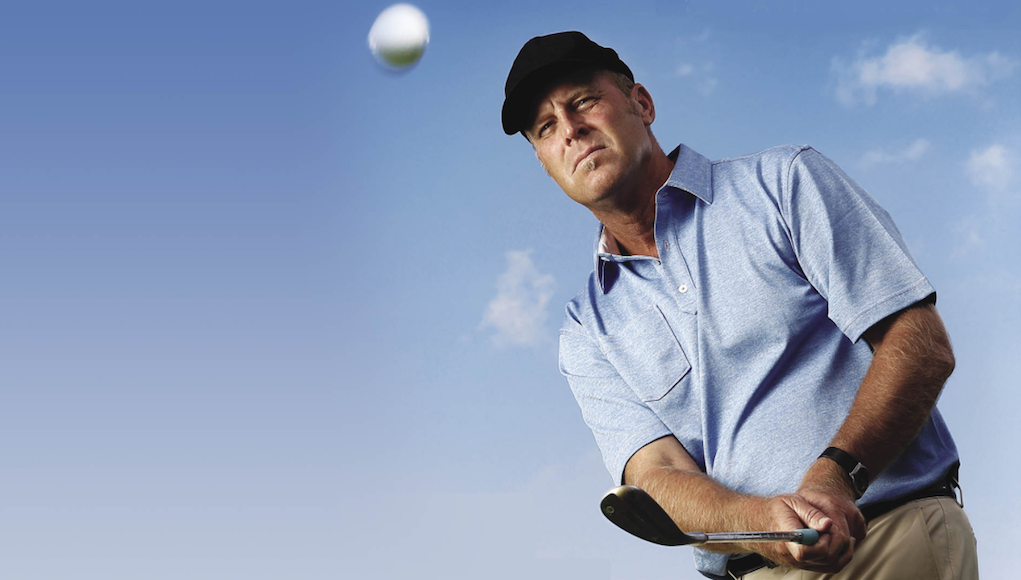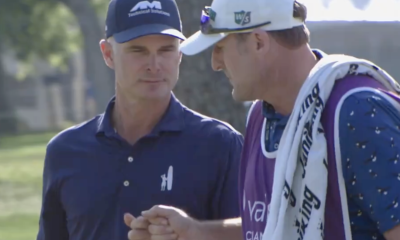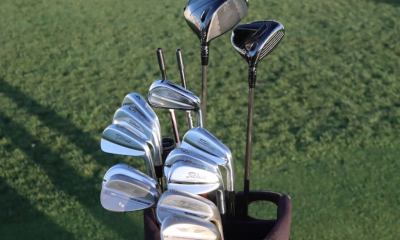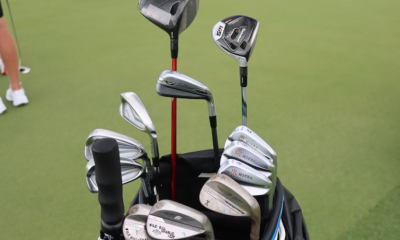Instruction
Inside the mind of short-game guru James Sieckmann

Countless people teach the short game for a living, but few have made a name for themselves like James Sieckmann. Not only was he a great golfer in his day, but he’s an even nicer guy. His cool, laid-back personality makes his students comfortable to improve and driven to make him proud.
Over the years I’ve gotten to know James as a person and a professional, and one thing is for certain: he’s a mentor to many and a friend to all. His simplistic, yet powerful short-game message has helped a range of clients from PGA Tour players to hopeful 100-breakers.
Sit back and enjoy the thoughts of James Sieckmann, one of the best teachers the short game has to offer.
Tom Stickney: You played professionally for quite some time. Has that helped you teach tour players?
James Sieckmann: Having played five, full-time years of professional golf has been a huge competitive advantage for me as a coach. It not only gave me empathy for the life, but the emotional struggles that come with it. It also allowed me to periodize changes with my players — when to make big changes, when to make small ones — and pay attention to all parts of what is required to progress and perform well: quality of training, preparing a yardage book and strategizing for certain courses, eating and workout plans, understanding how technique changes when confronted with different grasses and course conditions. I’m not sure you can be a great coach of tour-caliber players without that type of experience.
Can the professionals on Tour “get by” with their basic short-game shots, or do the changing course conditions require new techniques?
I get a lot of players that come to me with marginal mechanics, but they are skilled. They comment that they chip well on the mini-tours but when they get in a tour event they struggle. The lies on tour during the week of the event are often very tight and grainy, which demands an extra layer of precision and forgiveness that poor mechanics don’t afford.
What are the biggest mistakes that tour pros make within the three areas of pitching, bunker play and wedge game?
Everyone is good on tour, and of course there are a wide range of techniques and styles in every short game category. Aligning the stance too far left in the bunker is a very common mistake, which I think negatively effects the way the club can be delivered to produce a high-spinning shot that rolls straight when it lands. In distance wedges, it’s that they don’t practice this type of shot enough. Many ranges don’t have great targets for less than 120 yards, and it takes effort to put them out like I ask my players to do. In pitching it’s that they over turn their lower body and hang onto their release. If you want to see someone do it perfectly that’s not one of my students then watch Geoff Olgivy strike a few soft, 15-yards shots.
Do you see the same correlations with the amateurs you teach?
Not really, except for the really highly skilled scratch-type player. They don’t call them “amateur mistakes” for nothing. If you stand on the lesson tee long enough, you will see it all.
How much should tour pros practice their short games? Scratch players? 20 handicappers?
I think tour players should invest about two-thirds of their practice time refining their touch, feel, judgement and precision in their short game. For 20 handicappers it’s a bit less, because being proficient and driving the ball is such a big deal at that level. Let’s say half. Beginners need to develop solid technique before they can see the benefit of skill development practice, so I would say one-third. As they say, “If you can’t putt you can’t score, but if you can’t drive it you can’t play.” Full swing for them comes first.
What is the most important thing you have learned about the short game that would surprise people?
Confidence and a clear mind trump technical proficiency any day, which is why so many of us where better at it as kids than as adults.
Do you make revisions to your method based on idiosyncrasies that a player might have?
I have simple, foundational pieces to what I believe that are somewhat non-negotiable, but there aren’t many of them and there is an amazing potential for differing styles and blended motor patterns. Often my players look completely different performing a skill, but in my mind the key elements are essentially the same. I always say, “You got to let the player be the player.”
Can you give us a quick tip on how to pitch the ball close out of deep rough?
When a ball is sitting down in thick rough you need to steepen the angle of attack of the club head into the ball, which is done easily in the setup by either putting the ball back in your stance and playing a lower shot, or by widening out the stance, sitting a bit more and leaning into the lead quadriceps. Depending on the moisture in the grass, density and grain, you need to add energy or swing length to get the ball to come out a normal distance.
For more about James Sieckmann, check out his golf academy.
- LIKE182
- LEGIT22
- WOW9
- LOL2
- IDHT5
- FLOP0
- OB0
- SHANK14
Instruction
The Wedge Guy: The easiest-to-learn golf basic

My golf learning began with this simple fact – if you don’t have a fundamentally sound hold on the golf club, it is practically impossible for your body to execute a fundamentally sound golf swing. I’m still a big believer that the golf swing is much easier to execute if you begin with the proper hold on the club.
As you might imagine, I come into contact with hundreds of golfers of all skill levels. And it is very rare to see a good player with a bad hold on the golf club. There are some exceptions, for sure, but they are very few and very far between, and they typically have beat so many balls with their poor grip that they’ve found a way to work around it.
The reality of biophysics is that the body moves only in certain ways – and the particulars of the way you hold the golf club can totally prevent a sound swing motion that allows the club to release properly through the impact zone. The wonderful thing is that anyone can learn how to put a fundamentally sound hold on the golf club, and you can practice it anywhere your hands are not otherwise engaged, like watching TV or just sitting and relaxing.
Whether you prefer an overlap, interlock or full-finger (not baseball!) grip on the club, the same fundamentals apply. Here are the major grip faults I see most often, in the order of the frequency:
Mis-aligned hands
By this I mean that the palms of the two hands are not parallel to each other. Too many golfers have a weak left hand and strong right, or vice versa. The easiest way to learn how to hold the club with your palms aligned properly is to grip a plain wooden ruler or yardstick. It forces the hands to align properly and shows you how that feels. If you grip and re-grip a yardstick several times, then grip a club, you’ll see that the learning curve is almost immediate.
The position of the grip in the upper/left hand
I also observe many golfers who have the butt of the grip too far into the heel pad of the upper hand (the left hand for right-handed players). It’s amazing how much easier it is to release the club through the ball if even 1/4-1/2″ of the butt is beyond the left heel pad. Try this yourself to see what I mean. Swing the club freely with just your left hand and notice the difference in its release from when you hold it at the end of the grip, versus gripping down even a half inch.
To help you really understand how this works, go to the range and hit shots with your five-iron gripped down a full inch to make the club the same length as your seven-iron. You will probably see an amazing shot shape difference, and likely not see as much distance loss as you would expect.
Too much lower (right) hand on the club
It seems like almost all golfers of 8-10 handicap or higher have the club too far into the palm of the lower hand, because that feels “good” if you are trying to control the path of the clubhead to the ball. But the golf swing is not an effort to hit at the ball – it is a swing of the club. The proper hold on the club has the grip underneath the pad at the base of the fingers. This will likely feel “weak” to you — like you cannot control the club like that. EXACTLY. You should not be trying to control the club with your lower/master hand.
Gripping too tightly
Nearly all golfers hold the club too tightly, which tenses up the forearms and prevents a proper release of the club through impact. In order for the club to move back and through properly, you must feel that the club is controlled by the last three fingers of the upper hand, and the middle two fingers of the lower hand. If you engage your thumbs and forefingers in “holding” the club, the result will almost always be a grip that is too tight. Try this for yourself. Hold the club in your upper hand only, and squeeze firmly with just the last three fingers, with the forefinger and thumb off the club entirely. You have good control, but your forearms are not tense. Then begin to squeeze down with your thumb and forefinger and observe the tensing of the entire forearm. This is the way we are made, so the key to preventing tenseness in the arms is to hold the club very lightly with the “pinchers” — the thumbs and forefingers.
So, those are what I believe are the four fundamentals of a good grip. Anyone can learn them in their home or office very quickly. There is no easier way to improve your ball striking consistency and add distance than giving more attention to the way you hold the golf club.
More from the Wedge Guy
- The Wedge Guy: Golf mastery begins with your wedge game
- The Wedge Guy: Why golf is 20 times harder than brain surgery
- The Wedge Guy: Musings on the golf ball rollback
- LIKE63
- LEGIT10
- WOW3
- LOL1
- IDHT0
- FLOP3
- OB0
- SHANK3
Instruction
Clement: Stop ripping off your swing with this drill!

Not the dreaded headcover under the armpit drill! As if your body is defective and can’t function by itself! Have you seen how incredible the human machine is with all the incredible feats of agility all kinds of athletes are accomplishing? You think your body is so defective (the good Lord is laughing his head off at you) that it needs a headcover tucked under the armpit so you can swing like T-Rex?
- LIKE0
- LEGIT1
- WOW2
- LOL0
- IDHT0
- FLOP0
- OB0
- SHANK2
Instruction
How a towel can fix your golf swing

This is a classic drill that has been used for decades. However, the world of marketed training aids has grown so much during that time that this simple practice has been virtually forgotten. Because why teach people how to play golf using everyday items when you can create and sell a product that reinforces the same thing? Nevertheless, I am here to give you helpful advice without running to the nearest Edwin Watts or adding something to your Amazon cart.
For the “scoring clubs,” having a solid connection between the arms and body during the swing, especially through impact, is paramount to creating long-lasting consistency. And keeping that connection throughout the swing helps rotate the shoulders more to generate more power to help you hit it farther. So, how does this drill work, and what will your game benefit from it? Well, let’s get into it.
Setup
You can use this for basic chip shots up to complete swings. I use this with every club in my bag, up to a 9 or 8-iron. It’s natural to create incrementally more separation between the arms and body as you progress up the set. So doing this with a high iron or a wood is not recommended.
While you set up to hit a ball, simply tuck the towel underneath both armpits. The length of the towel will determine how tight it will be across your chest but don’t make it so loose that it gets in the way of your vision. After both sides are tucked, make some focused swings, keeping both arms firmly connected to the body during the backswing and follow through. (Note: It’s normal to lose connection on your lead arm during your finishing pose.) When you’re ready, put a ball in the way of those swings and get to work.

Get a Better Shoulder Turn
Many of us struggle to have proper shoulder rotation in our golf swing, especially during long layoffs. Making a swing that is all arms and no shoulders is a surefire way to have less control with wedges and less distance with full swings. Notice how I can get in a similar-looking position in both 60° wedge photos. However, one is weak and uncontrollable, while the other is strong and connected. One allows me to use my larger muscles to create my swing, and one doesn’t. The follow-through is another critical point where having a good connection, as well as solid shoulder rotation, is a must. This drill is great for those who tend to have a “chicken wing” form in their lead arm, which happens when it becomes separated from the body through impact.
In full swings, getting your shoulders to rotate in your golf swing is a great way to reinforce proper weight distribution. If your swing is all arms, it’s much harder to get your weight to naturally shift to the inside part of your trail foot in the backswing. Sure, you could make the mistake of “sliding” to get weight on your back foot, but that doesn’t fix the issue. You must turn into your trial leg to generate power. Additionally, look at the difference in separation between my hands and my head in the 8-iron examples. The green picture has more separation and has my hands lower. This will help me lessen my angle of attack and make it easier to hit the inside part of the golf ball, rather than the over-the-top move that the other picture produces.


Stay Better Connected in the Backswing
When you don’t keep everything in your upper body working as one, getting to a good spot at the top of your swing is very hard to do. It would take impeccable timing along with great hand-eye coordination to hit quality shots with any sort of regularity if the arms are working separately from the body.
Notice in the red pictures of both my 60-degree wedge and 8-iron how high my hands are and the fact you can clearly see my shoulder through the gap in my arms. That has happened because the right arm, just above my elbow, has become totally disconnected from my body. That separation causes me to lift my hands as well as lose some of the extension in my left arm. This has been corrected in the green pictures by using this drill to reinforce that connection. It will also make you focus on keeping the lead arm close to your body as well. Because the moment either one loses that relationship, the towel falls.


Conclusion
I have been diligent this year in finding a few drills that target some of the issues that plague my golf game; either by simply forgetting fundamental things or by coming to terms with the faults that have bitten me my whole career. I have found that having a few drills to fall back on to reinforce certain feelings helps me find my game a little easier, and the “towel drill” is most definitely one of them.
- LIKE11
- LEGIT1
- WOW2
- LOL0
- IDHT0
- FLOP2
- OB0
- SHANK8
-

 19th Hole5 days ago
19th Hole5 days agoJohn Daly stuns fans into silence with brutal opening tee shot on PGA Tour Champions
-

 19th Hole1 week ago
19th Hole1 week ago2-time major champ announces shock retirement from the sport at age of 33
-

 19th Hole5 days ago
19th Hole5 days agoCharlie Woods finds it tough going on American Junior Golf Association debut
-

 19th Hole1 week ago
19th Hole1 week agoEdoardo Molinari reveals the latest PGA Tour golfer to turn down ‘good offer’ from LIV Golf
-

 19th Hole2 weeks ago
19th Hole2 weeks agoScottie Scheffler had an interesting response when asked how he ‘quiets the noise’ following Players victory
-

 Equipment2 weeks ago
Equipment2 weeks agoBest driver 2024: The best driver for you, as recommend by expert club fitters
-

 19th Hole2 weeks ago
19th Hole2 weeks agoJon Rahm dealt fresh blow to hopes of qualifying for 2025 Ryder Cup
-

 19th Hole1 week ago
19th Hole1 week agoWhy Kevin Streelman sought USGA approval to use this equipment tool as he leads Valspar after round one





















Jalan
Apr 1, 2017 at 6:40 pm
I just obtained his short game book, gave it a quick read. Today I took what I had read to the practice range, and I was really impressed by my results. While I was ‘familiar’ with some of his techniques, I didn’t know or understand the full finesse swing. I can see how this is going to greatly improve my short game. I’m looking forward to delving further into his book, and taking what I learn to the course this season.
I encourage anyone wanting a simpler, more effective short game to obtain and study this book. You won’t regret it…but, your opponents will.
PineStreetGolf
Mar 23, 2017 at 9:22 am
His short-game book is fantastic. I’m not as sold on his putting book, because its extremely rigid which doesn’t *seem* right when learning how to put (my way or the highway type approach). But his short game book is probably the best book i’ve ever read about how to play golf.
golfraven
Mar 22, 2017 at 10:05 am
Bought both books – Putting & Short Game Solutions. Expect great things after I put in the efforts 😉
Dill Pickelson
Mar 22, 2017 at 3:20 am
Sieckmann changed my life. I can get up/down from anywhere with a variety of clubs with his method and it was easy to learn.
Double Mocha Man
Mar 21, 2017 at 5:43 pm
At the risk of exposing the weak spot in my game, I too, just bought the book.
M-Herd4
Mar 21, 2017 at 11:58 am
Just bought his book and really looking forward to reading it. My biggest struggle this past season was my wedge game. Hopefully this will help this year…